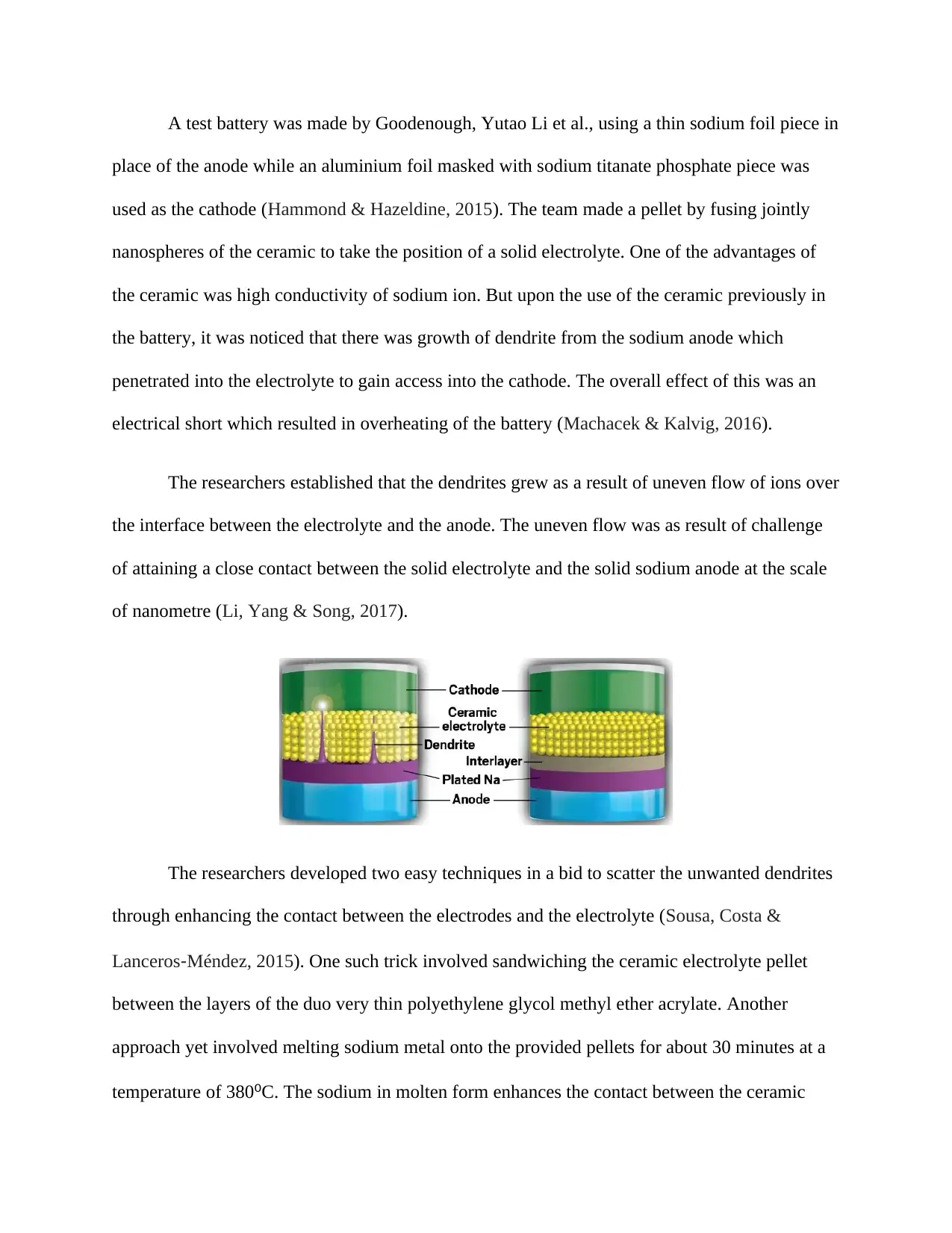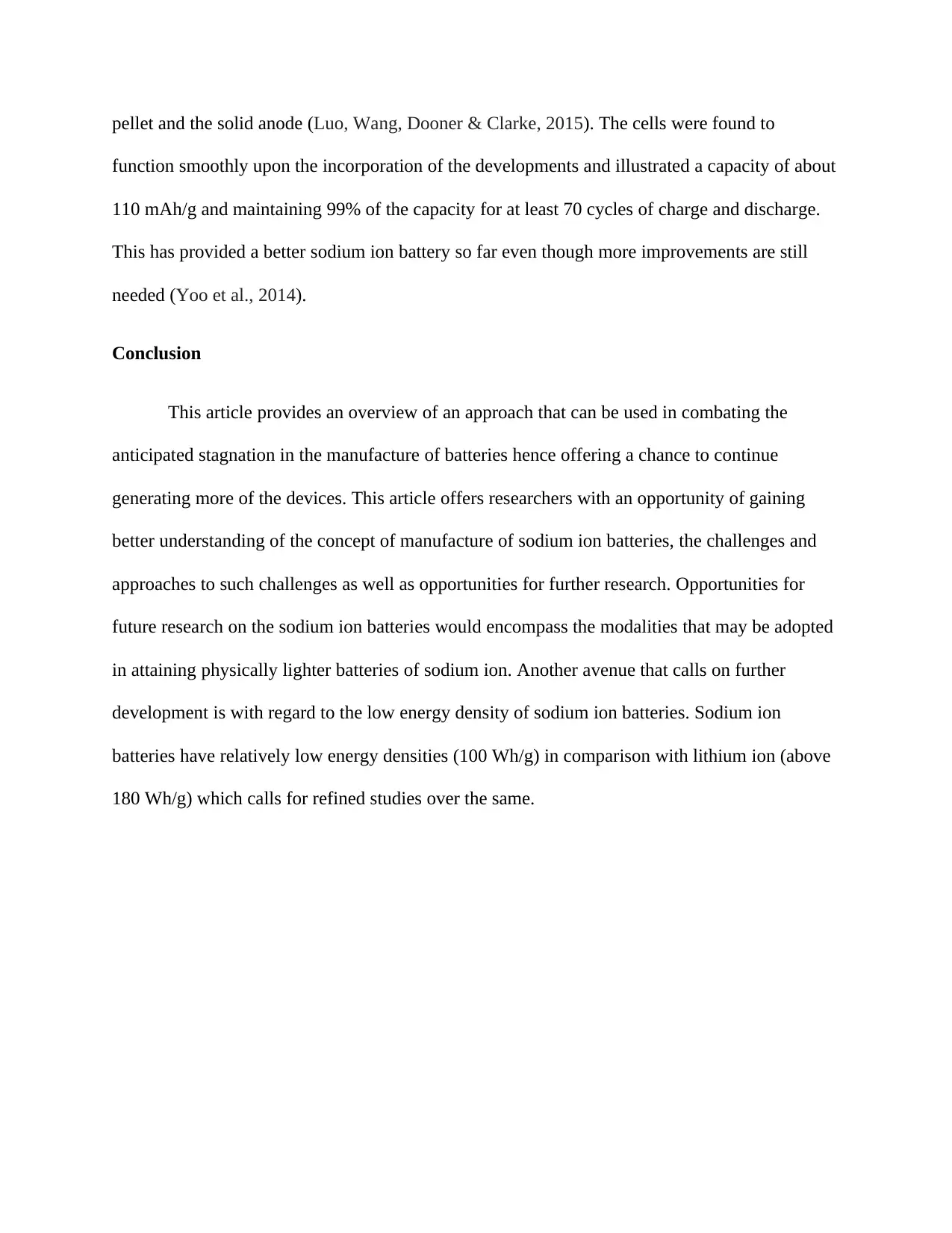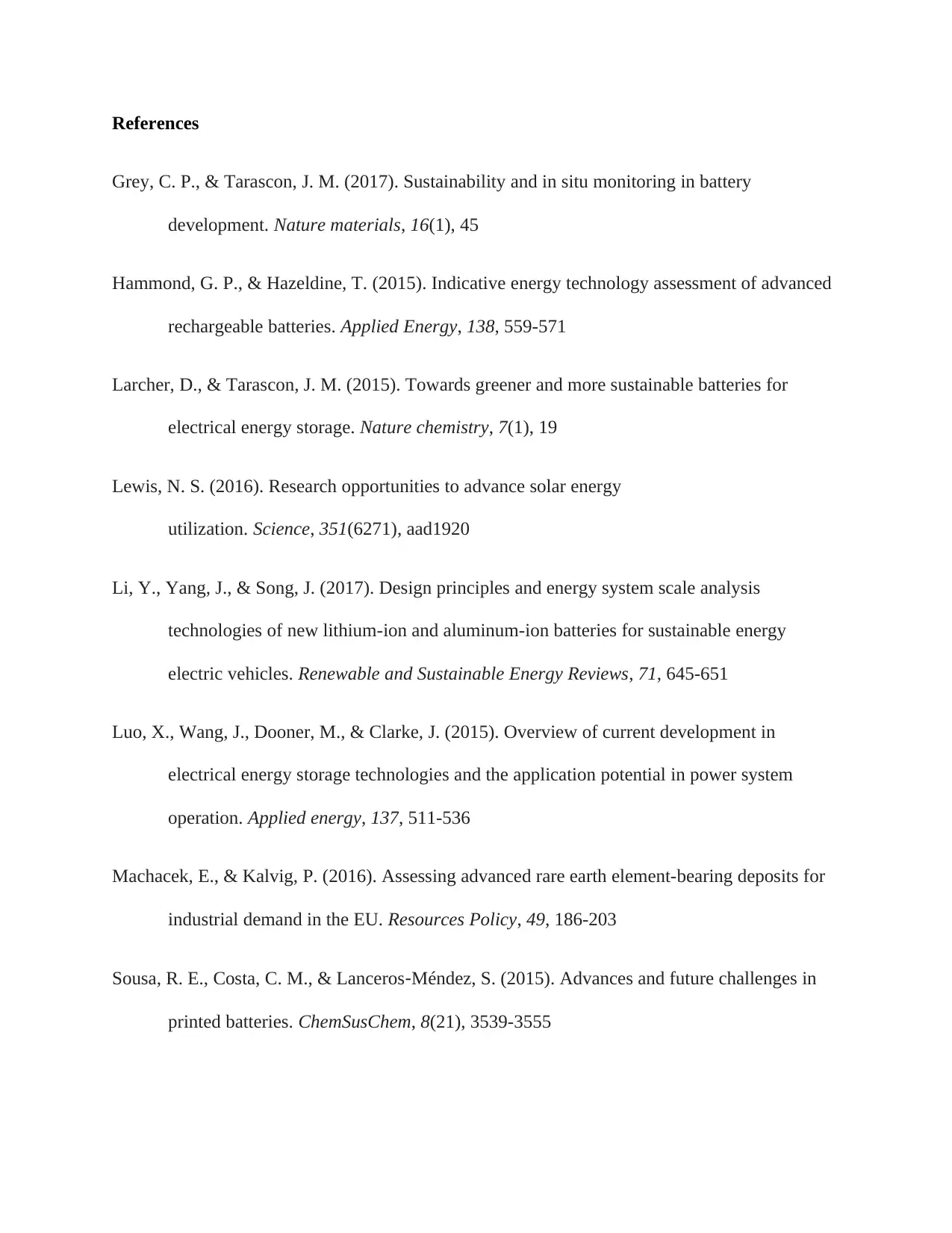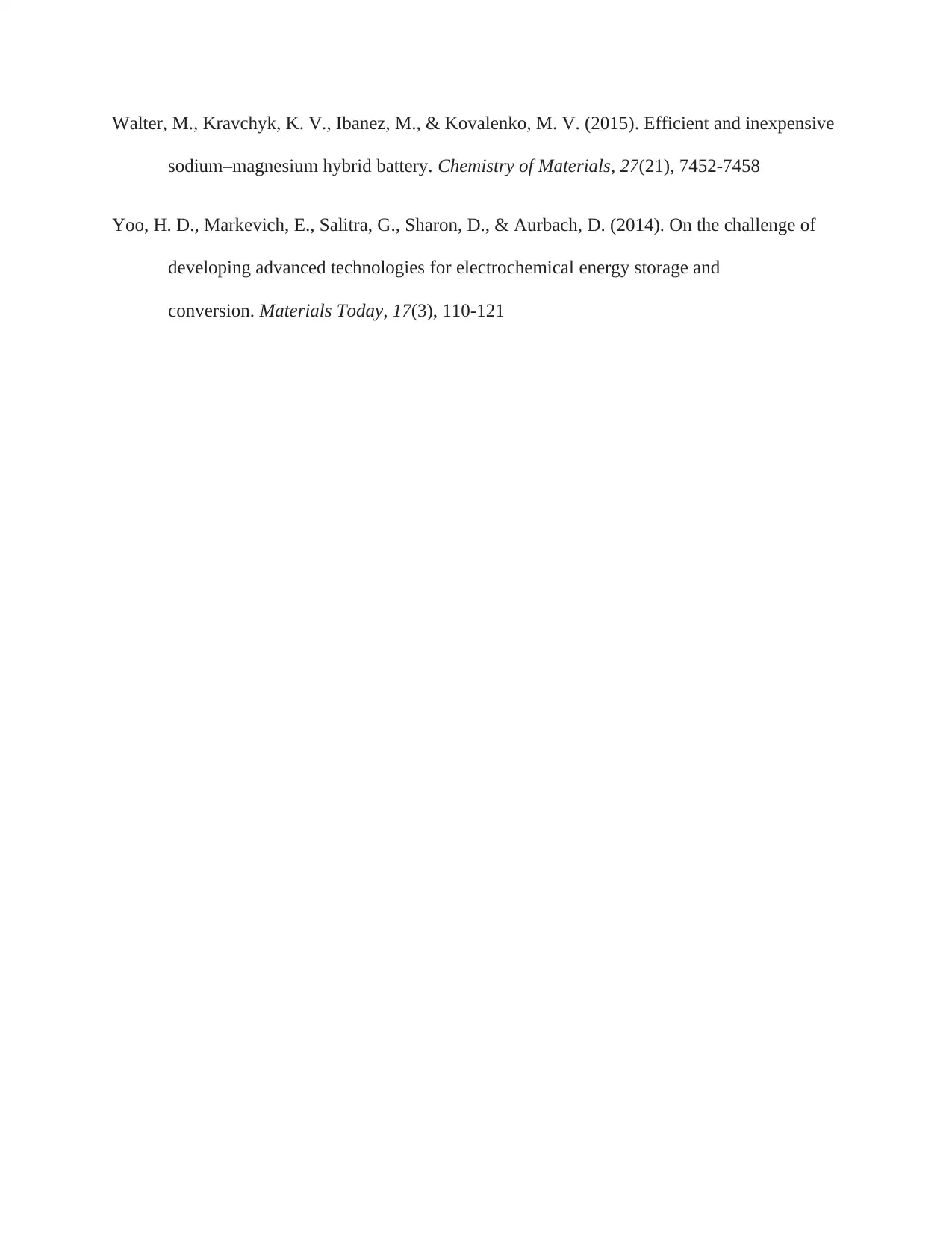Sodium-Ion Batteries: Reflection on Challenges and Opportunities
VerifiedAdded on 2023/06/04
|6
|1245
|72
Essay
AI Summary
This reflection paper discusses the potential transition from lithium-ion to sodium-ion batteries due to the scarcity and cost of lithium. It highlights the key themes of how sodium-ion batteries work, the challenges associated with their use (especially sodium's reactivity), and the modalities for addressing these challenges. The paper references a test battery development by Goodenough, Yutao Li et al., and their efforts to overcome dendrite formation, which causes electrical shorts. The researchers developed techniques to enhance contact between the electrodes and electrolyte, improving battery function. The paper concludes that sodium-ion batteries present a viable alternative, offering opportunities for future research, particularly in reducing battery weight and increasing energy density, which are currently lower than lithium-ion batteries. Desklib offers this paper as a resource for students along with numerous other solved assignments.

REFLECTION PAPER
[Author Name(s), First M. Last, Omit Titles and Degrees]
[Institutional Affiliation(s)]
[Author Name(s), First M. Last, Omit Titles and Degrees]
[Institutional Affiliation(s)]
Paraphrase This Document
Need a fresh take? Get an instant paraphrase of this document with our AI Paraphraser

Introduction
The main focus of the article is a transition from the use of lithium-ions in the
manufacture of batteries to the use of sodium ions. Lithium has for several decades been used as
the material for the manufacture of batteries. Being a mineral, the lithium reserves are
continually being exhausted day by day as more of the mineral is continuously being mined
(Larcher & Tarascon, 2015). An exhaustion of the mineral reserves may culminate into a
complete halt in the production of batteries hence the article tends to provide an alternative to
this forecasted scenario through the introduction of sodium which is not only cheap but also in
abundance all over the surface of the earth. Concepts or theories among them electrochemistry
could be ideal in gaining an in-depth into the article by offering a wider berth of analysis. The
key themes in the article are hoe the sodium ion batteries would work, the challenges besides the
modalities that would be adopted in ensuring that the challenges are effectively addressed and
the best out of the sodium batteries is achieved (Grey & Tarascon, 2017).
Key Themes
Lithium ions have turned out to be neither cheaper nor in abundance. Sodium is a highly
reactive and thus explosive substance, a property that has made its use limited and greatly
controlled to ensure there are no harms or damages incurred (Walter et al., 2015). This property
has effectively been continued with the efforts of making the sodium ion batteries just as
functional as the lithium ion counterparts. During the process of charging there is floe of metal
ions from the cathode which is often a compound that contains sodium to the anode which is
typically the carbon via the electrolyte which is an organic solvent that has dissolved sodium
salts. The direction of the flow reverses during the process of discharging (Lewis, 2016).
The main focus of the article is a transition from the use of lithium-ions in the
manufacture of batteries to the use of sodium ions. Lithium has for several decades been used as
the material for the manufacture of batteries. Being a mineral, the lithium reserves are
continually being exhausted day by day as more of the mineral is continuously being mined
(Larcher & Tarascon, 2015). An exhaustion of the mineral reserves may culminate into a
complete halt in the production of batteries hence the article tends to provide an alternative to
this forecasted scenario through the introduction of sodium which is not only cheap but also in
abundance all over the surface of the earth. Concepts or theories among them electrochemistry
could be ideal in gaining an in-depth into the article by offering a wider berth of analysis. The
key themes in the article are hoe the sodium ion batteries would work, the challenges besides the
modalities that would be adopted in ensuring that the challenges are effectively addressed and
the best out of the sodium batteries is achieved (Grey & Tarascon, 2017).
Key Themes
Lithium ions have turned out to be neither cheaper nor in abundance. Sodium is a highly
reactive and thus explosive substance, a property that has made its use limited and greatly
controlled to ensure there are no harms or damages incurred (Walter et al., 2015). This property
has effectively been continued with the efforts of making the sodium ion batteries just as
functional as the lithium ion counterparts. During the process of charging there is floe of metal
ions from the cathode which is often a compound that contains sodium to the anode which is
typically the carbon via the electrolyte which is an organic solvent that has dissolved sodium
salts. The direction of the flow reverses during the process of discharging (Lewis, 2016).

A test battery was made by Goodenough, Yutao Li et al., using a thin sodium foil piece in
place of the anode while an aluminium foil masked with sodium titanate phosphate piece was
used as the cathode (Hammond & Hazeldine, 2015). The team made a pellet by fusing jointly
nanospheres of the ceramic to take the position of a solid electrolyte. One of the advantages of
the ceramic was high conductivity of sodium ion. But upon the use of the ceramic previously in
the battery, it was noticed that there was growth of dendrite from the sodium anode which
penetrated into the electrolyte to gain access into the cathode. The overall effect of this was an
electrical short which resulted in overheating of the battery (Machacek & Kalvig, 2016).
The researchers established that the dendrites grew as a result of uneven flow of ions over
the interface between the electrolyte and the anode. The uneven flow was as result of challenge
of attaining a close contact between the solid electrolyte and the solid sodium anode at the scale
of nanometre (Li, Yang & Song, 2017).
The researchers developed two easy techniques in a bid to scatter the unwanted dendrites
through enhancing the contact between the electrodes and the electrolyte (Sousa, Costa &
Lanceros‐Méndez, 2015). One such trick involved sandwiching the ceramic electrolyte pellet
between the layers of the duo very thin polyethylene glycol methyl ether acrylate. Another
approach yet involved melting sodium metal onto the provided pellets for about 30 minutes at a
temperature of 380⁰C. The sodium in molten form enhances the contact between the ceramic
place of the anode while an aluminium foil masked with sodium titanate phosphate piece was
used as the cathode (Hammond & Hazeldine, 2015). The team made a pellet by fusing jointly
nanospheres of the ceramic to take the position of a solid electrolyte. One of the advantages of
the ceramic was high conductivity of sodium ion. But upon the use of the ceramic previously in
the battery, it was noticed that there was growth of dendrite from the sodium anode which
penetrated into the electrolyte to gain access into the cathode. The overall effect of this was an
electrical short which resulted in overheating of the battery (Machacek & Kalvig, 2016).
The researchers established that the dendrites grew as a result of uneven flow of ions over
the interface between the electrolyte and the anode. The uneven flow was as result of challenge
of attaining a close contact between the solid electrolyte and the solid sodium anode at the scale
of nanometre (Li, Yang & Song, 2017).
The researchers developed two easy techniques in a bid to scatter the unwanted dendrites
through enhancing the contact between the electrodes and the electrolyte (Sousa, Costa &
Lanceros‐Méndez, 2015). One such trick involved sandwiching the ceramic electrolyte pellet
between the layers of the duo very thin polyethylene glycol methyl ether acrylate. Another
approach yet involved melting sodium metal onto the provided pellets for about 30 minutes at a
temperature of 380⁰C. The sodium in molten form enhances the contact between the ceramic
⊘ This is a preview!⊘
Do you want full access?
Subscribe today to unlock all pages.

Trusted by 1+ million students worldwide

pellet and the solid anode (Luo, Wang, Dooner & Clarke, 2015). The cells were found to
function smoothly upon the incorporation of the developments and illustrated a capacity of about
110 mAh/g and maintaining 99% of the capacity for at least 70 cycles of charge and discharge.
This has provided a better sodium ion battery so far even though more improvements are still
needed (Yoo et al., 2014).
Conclusion
This article provides an overview of an approach that can be used in combating the
anticipated stagnation in the manufacture of batteries hence offering a chance to continue
generating more of the devices. This article offers researchers with an opportunity of gaining
better understanding of the concept of manufacture of sodium ion batteries, the challenges and
approaches to such challenges as well as opportunities for further research. Opportunities for
future research on the sodium ion batteries would encompass the modalities that may be adopted
in attaining physically lighter batteries of sodium ion. Another avenue that calls on further
development is with regard to the low energy density of sodium ion batteries. Sodium ion
batteries have relatively low energy densities (100 Wh/g) in comparison with lithium ion (above
180 Wh/g) which calls for refined studies over the same.
function smoothly upon the incorporation of the developments and illustrated a capacity of about
110 mAh/g and maintaining 99% of the capacity for at least 70 cycles of charge and discharge.
This has provided a better sodium ion battery so far even though more improvements are still
needed (Yoo et al., 2014).
Conclusion
This article provides an overview of an approach that can be used in combating the
anticipated stagnation in the manufacture of batteries hence offering a chance to continue
generating more of the devices. This article offers researchers with an opportunity of gaining
better understanding of the concept of manufacture of sodium ion batteries, the challenges and
approaches to such challenges as well as opportunities for further research. Opportunities for
future research on the sodium ion batteries would encompass the modalities that may be adopted
in attaining physically lighter batteries of sodium ion. Another avenue that calls on further
development is with regard to the low energy density of sodium ion batteries. Sodium ion
batteries have relatively low energy densities (100 Wh/g) in comparison with lithium ion (above
180 Wh/g) which calls for refined studies over the same.
Paraphrase This Document
Need a fresh take? Get an instant paraphrase of this document with our AI Paraphraser

References
Grey, C. P., & Tarascon, J. M. (2017). Sustainability and in situ monitoring in battery
development. Nature materials, 16(1), 45
Hammond, G. P., & Hazeldine, T. (2015). Indicative energy technology assessment of advanced
rechargeable batteries. Applied Energy, 138, 559-571
Larcher, D., & Tarascon, J. M. (2015). Towards greener and more sustainable batteries for
electrical energy storage. Nature chemistry, 7(1), 19
Lewis, N. S. (2016). Research opportunities to advance solar energy
utilization. Science, 351(6271), aad1920
Li, Y., Yang, J., & Song, J. (2017). Design principles and energy system scale analysis
technologies of new lithium-ion and aluminum-ion batteries for sustainable energy
electric vehicles. Renewable and Sustainable Energy Reviews, 71, 645-651
Luo, X., Wang, J., Dooner, M., & Clarke, J. (2015). Overview of current development in
electrical energy storage technologies and the application potential in power system
operation. Applied energy, 137, 511-536
Machacek, E., & Kalvig, P. (2016). Assessing advanced rare earth element-bearing deposits for
industrial demand in the EU. Resources Policy, 49, 186-203
Sousa, R. E., Costa, C. M., & Lanceros‐Méndez, S. (2015). Advances and future challenges in
printed batteries. ChemSusChem, 8(21), 3539-3555
Grey, C. P., & Tarascon, J. M. (2017). Sustainability and in situ monitoring in battery
development. Nature materials, 16(1), 45
Hammond, G. P., & Hazeldine, T. (2015). Indicative energy technology assessment of advanced
rechargeable batteries. Applied Energy, 138, 559-571
Larcher, D., & Tarascon, J. M. (2015). Towards greener and more sustainable batteries for
electrical energy storage. Nature chemistry, 7(1), 19
Lewis, N. S. (2016). Research opportunities to advance solar energy
utilization. Science, 351(6271), aad1920
Li, Y., Yang, J., & Song, J. (2017). Design principles and energy system scale analysis
technologies of new lithium-ion and aluminum-ion batteries for sustainable energy
electric vehicles. Renewable and Sustainable Energy Reviews, 71, 645-651
Luo, X., Wang, J., Dooner, M., & Clarke, J. (2015). Overview of current development in
electrical energy storage technologies and the application potential in power system
operation. Applied energy, 137, 511-536
Machacek, E., & Kalvig, P. (2016). Assessing advanced rare earth element-bearing deposits for
industrial demand in the EU. Resources Policy, 49, 186-203
Sousa, R. E., Costa, C. M., & Lanceros‐Méndez, S. (2015). Advances and future challenges in
printed batteries. ChemSusChem, 8(21), 3539-3555

Walter, M., Kravchyk, K. V., Ibanez, M., & Kovalenko, M. V. (2015). Efficient and inexpensive
sodium–magnesium hybrid battery. Chemistry of Materials, 27(21), 7452-7458
Yoo, H. D., Markevich, E., Salitra, G., Sharon, D., & Aurbach, D. (2014). On the challenge of
developing advanced technologies for electrochemical energy storage and
conversion. Materials Today, 17(3), 110-121
sodium–magnesium hybrid battery. Chemistry of Materials, 27(21), 7452-7458
Yoo, H. D., Markevich, E., Salitra, G., Sharon, D., & Aurbach, D. (2014). On the challenge of
developing advanced technologies for electrochemical energy storage and
conversion. Materials Today, 17(3), 110-121
⊘ This is a preview!⊘
Do you want full access?
Subscribe today to unlock all pages.

Trusted by 1+ million students worldwide
1 out of 6
Your All-in-One AI-Powered Toolkit for Academic Success.
+13062052269
info@desklib.com
Available 24*7 on WhatsApp / Email
![[object Object]](/_next/static/media/star-bottom.7253800d.svg)
Unlock your academic potential
Copyright © 2020–2025 A2Z Services. All Rights Reserved. Developed and managed by ZUCOL.
